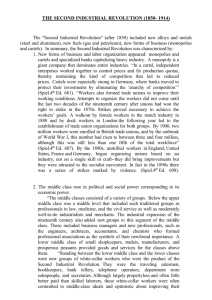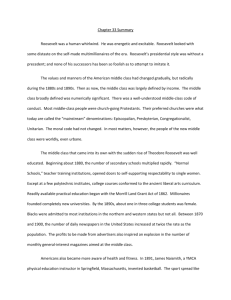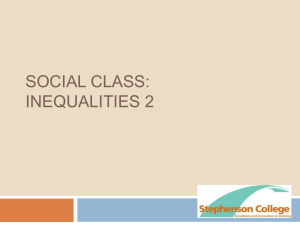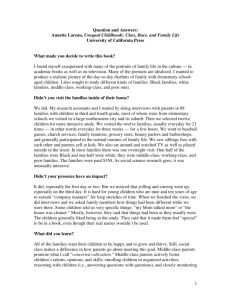Concerted Cultivation and the Accomplishment of Natural Growth
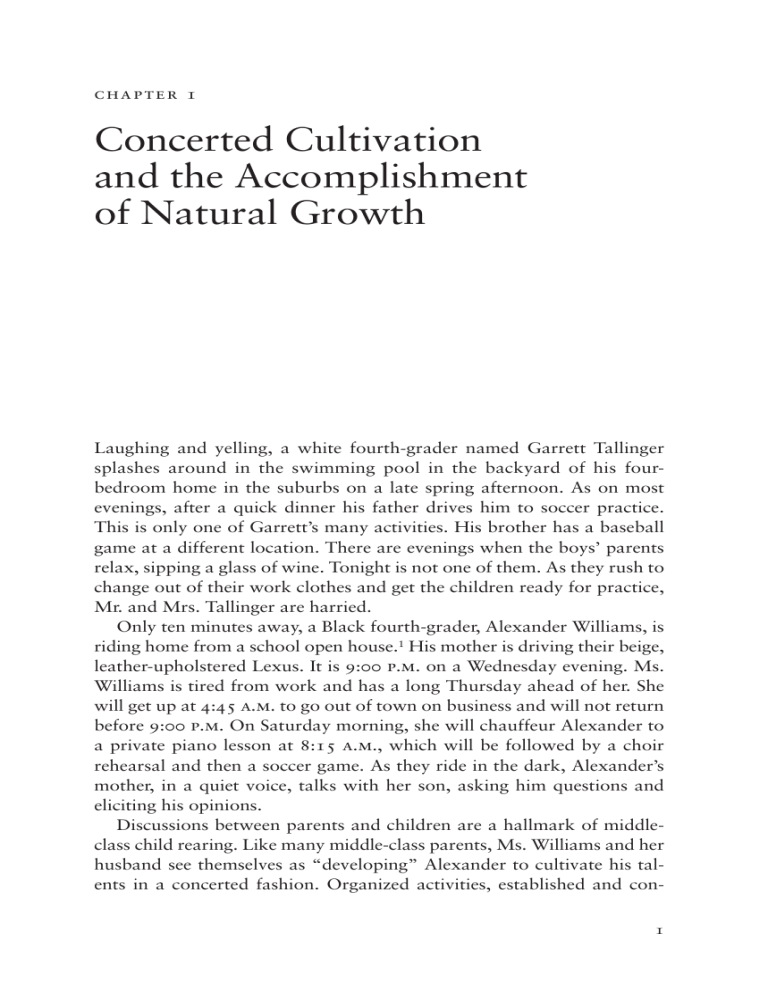
c h a p t e r 1
Concerted Cultivation and the Accomplishment of Natural Growth
Laughing and yelling, a white fourth-grader named Garrett Tallinger splashes around in the swimming pool in the backyard of his fourbedroom home in the suburbs on a late spring afternoon. As on most evenings, after a quick dinner his father drives him to soccer practice.
This is only one of Garrett’s many activities. His brother has a baseball game at a different location. There are evenings when the boys’ parents relax, sipping a glass of wine. Tonight is not one of them. As they rush to change out of their work clothes and get the children ready for practice,
Mr. and Mrs. Tallinger are harried.
Only ten minutes away, a Black fourth-grader, Alexander Williams, is riding home from a school open house.
1 His mother is driving their beige, leather-upholstered Lexus. It is 9:00 p.m.
on a Wednesday evening. Ms.
Williams is tired from work and has a long Thursday ahead of her. She will get up at 4:45 a.m.
to go out of town on business and will not return before 9:00 p.m.
On Saturday morning, she will chauffeur Alexander to a private piano lesson at 8:15 a.m
., which will be followed by a choir rehearsal and then a soccer game. As they ride in the dark, Alexander’s mother, in a quiet voice, talks with her son, asking him questions and eliciting his opinions.
Discussions between parents and children are a hallmark of middleclass child rearing. Like many middle-class parents, Ms. Williams and her husband see themselves as “developing” Alexander to cultivate his talents in a concerted fashion. Organized activities, established and con-
1
2 Concerted Cultivation and Natural Growth trolled by mothers and fathers, dominate the lives of middle-class children such as Garrett and Alexander. By making certain their children have these and other experiences, middle-class parents engage in a process of concerted cultivation.
From this, a robust sense of entitlement takes root in the children. This sense of entitlement plays an especially important role in institutional settings, where middle-class children learn to question adults and address them as relative equals.
Only twenty minutes away, in blue-collar neighborhoods, and slightly farther away, in public housing projects, childhood looks different. Mr.
Yanelli, a white working-class father, picks up his son Little Billy, a fourth-grader, from an after-school program. They come home and Mr.
Yanelli drinks a beer while Little Billy first watches television, then rides his bike and plays in the street. Other nights, he and his Dad sit on the sidewalk outside their house and play cards. At about 5:30 p.m.
Billy’s mother gets home from her job as a house cleaner. She fixes dinner and the entire family sits down to eat together. Extended family are a prominent part of their lives. Ms. Yanelli touches base with her “entire family every day” by phone. Many nights Little Billy’s uncle stops by, sometimes bringing Little Billy’s youngest cousin. In the spring, Little Billy plays baseball on a local team. Unlike for Garrett and Alexander, who have at least four activities a week, for Little Billy, baseball is his only organized activity outside of school during the entire year. Down the road, a white working-class girl, Wendy Driver, also spends the evening with her girl cousins, as they watch a video and eat popcorn, crowded together on the living room floor.
Farther away, a Black fourth-grade boy, Harold McAllister, plays outside on a summer evening in the public housing project in which he lives.
His two male cousins are there that night, as they often are. After an afternoon spent unsuccessfully searching for a ball so they could play basketball, the boys had resorted to watching sports on television. Now they head outdoors for a twilight water balloon fight. Harold tries to get his neighbor, Miss Latifa, wet. People sit in white plastic lawn chairs outside the row of apartments. Music and television sounds waft through the open windows and doors.
The adults in the lives of Billy, Wendy, and Harold want the best for them. Formidable economic constraints make it a major life task for these parents to put food on the table, arrange for housing, negotiate unsafe neighborhoods, take children to the doctor (often waiting for city buses that do not come), clean children’s clothes, and get children to bed and have them ready for school the next morning. But unlike middle-
Concerted Cultivation and Natural Growth 3 class parents, these adults do not consider the concerted development of children, particularly through organized leisure activities, an essential aspect of good parenting. Unlike the Tallingers and Williamses, these mothers and fathers do not focus on concerted cultivation. For them, the crucial responsibilities of parenthood do not lie in eliciting their children’s feelings, opinions, and thoughts. Rather, they see a clear boundary between adults and children. Parents tend to use directives: they tell their children what to do rather than persuading them with reasoning. Unlike their middle-class counterparts, who have a steady diet of adult organized activities, the working-class and poor children have more control over the character of their leisure activities. Most children are free to go out and play with friends and relatives who typically live close by. Their parents and guardians facilitate the accomplishment of natural growth.
2
Yet these children and their parents interact with central institutions in the society, such as schools, which firmly and decisively promote strategies of concerted cultivation in child rearing. For working-class and poor families, the cultural logic of child rearing at home is out of synch with the standards of institutions. As a result, while children whose parents adopt strategies of concerted cultivation appear to gain a sense of entitlement, children such as Billy Yanelli, Wendy Driver, and Harold
McAllister appear to gain an emerging sense of distance, distrust, and constraint in their institutional experiences.
America may be the land of opportunity, but it is also a land of inequality. This book identifies the largely invisible but powerful ways that parents’ social class impacts children’s life experiences. It shows, using indepth observations and interviews with middle-class (including members of the upper-middle-class), working-class, and poor families, that inequality permeates the fabric of the culture. In the chapters that lie ahead, I report the results of intensive observational research for a total of twelve families when their children were nine and ten years old. I argue that key elements of family life cohere to form a cultural logic of child rearing.
3 In other words, the differences among families seem to cluster together in meaningful patterns. In this historical moment, middle-class parents tend to adopt a cultural logic of child rearing that stresses the concerted cultivation of children. Working-class and poor parents, by contrast, tend to undertake the accomplishment of natural growth. In the accomplishment of natural growth, children experience long stretches of leisure time, child-initiated play, clear boundaries between adults and children, and daily interactions with kin. Workingclass and poor children, despite tremendous economic strain, often have
4 Concerted Cultivation and Natural Growth more “childlike” lives, with autonomy from adults and control over their extended leisure time. Although middle-class children miss out on kin relationships and leisure time, they appear to (at least potentially) gain important institutional advantages. From the experience of concerted cultivation, they acquire skills that could be valuable in the future when they enter the world of work. Middle-class white and Black children in my study did exhibit some key differences; yet the biggest gaps were not within social classes but, as I show, across them. It is these class differences and how they are enacted in family life and child rearing that shape the ways children view themselves in relation to the rest of the world.
Cultural Reper toires
Professionals who work with children, such as teachers, doctors, and counselors, generally agree about how children should be raised. Of course, from time to time they may disagree on the ways standards should be enacted for an individual child or family. For example, teachers may disagree about whether or not parents should stop and correct a child who mispronounces a word while reading. Counselors may disagree over whether a mother is being too protective of her child. Still, there is little dispute among professionals on the broad principles for promoting educational development in children through proper parenting.
4 These standards include the importance of talking with children, developing their educational interests, and playing an active role in their schooling. Similarly, parenting guidelines typically stress the importance of reasoning with children and teaching them to solve problems through negotiation rather than with physical force. Because these guidelines are so generally accepted, and because they focus on a set of practices concerning how parents should raise children, they form a dominant set of cultural repertoires about how children should be raised. This widespread agreement among professionals about the broad principles for child rearing permeates our society. A small number of experts thus potentially shape the behavior of a large number of parents.
Professionals’ advice regarding the best way to raise children has changed regularly over the last two centuries. From strong opinions about the merits of bottle feeding, being stern with children, and utilizing physical punishment (with dire warnings of problematic outcomes should parents indulge children), there have been shifts to equally strongly worded recommendations about the benefits of breast feeding, displaying emotional warmth toward children, and using reasoning and negotiation
Concerted Cultivation and Natural Growth 5 as mechanisms of parental control. Middle-class parents appear to shift their behaviors in a variety of spheres more rapidly and more thoroughly than do working-class or poor parents.
5 As professionals have shifted their recommendations from bottle feeding to breast feeding, from stern approaches to warmth and empathy, and from spanking to time-outs, it is middle-class parents who have responded most promptly.
6 Moreover, in recent decades, middle-class children in the United States have had to face the prospect of “declining fortunes.” 7 Worried about how their children will get ahead, middle-class parents are increasingly determined to make sure that their children are not excluded from any opportunity that might eventually contribute to their advancement.
Middle-class parents who comply with current professional standards and engage in a pattern of concerted cultivation deliberately try to stimulate their children’s development and foster their cognitive and social skills. The commitment among working-class and poor families to provide comfort, food, shelter, and other basic support requires ongoing effort, given economic challenges and the formidable demands of child rearing. But it stops short of the deliberate cultivation of children and their leisure activities that occurs in middle-class families. For workingclass and poor families, sustaining children’s natural growth is viewed as an accomplishment.
8
What is the outcome of these different philosophies and approaches to child rearing? Quite simply, they appear to lead to the transmission of differential advantages to children. In this study, there was quite a bit more talking in middle-class homes than in working-class and poor homes, leading to the development of greater verbal agility, larger vocabularies, more comfort with authority figures, and more familiarity with abstract concepts. Importantly, children also developed skill differences in interacting with authority figures in institutions and at home. Middleclass children such as Garrett Tallinger and Alexander Williams learn, as young boys, to shake the hands of adults and look them in the eye. In studies of job interviews, investigators have found that potential employees have less than one minute to make a good impression. Researchers stress the importance of eye contact, firm handshakes, and displaying comfort with bosses during the interview. In poor families like Harold
McAllister’s, however, family members usually do not look each other in the eye when conversing. In addition, as Elijah Anderson points out, they live in neighborhoods where it can be dangerous to look people in the eye too long.
9 The types of social competence transmitted in the
McAllister family are valuable, but they are potentially less valuable (in
6 Concerted Cultivation and Natural Growth employment interviews, for example) than those learned by Garrett
Tallinger and Alexander Williams.
The white and Black middle-class children in this study also exhibited an emergent version of the sense of entitlement characteristic of the middle-class. They acted as though they had a right to pursue their own individual preferences and to actively manage interactions in institutional settings. They appeared comfortable in these settings; they were open to sharing information and asking for attention. Although some children were more outgoing than others, it was common practice among middleclass children to shift interactions to suit their preferences. Alexander
Williams knew how to get the doctor to listen to his concerns (about the bumps under his arm from his new deodorant). His mother explicitly trained and encouraged him to speak up with the doctor. Similarly, a
Black middle-class girl, Stacey Marshall, was taught by her mother to expect the gymnastics teacher to accommodate her individual learning style. Thus, middle-class children were trained in “the rules of the game” that govern interactions with institutional representatives. They were not conversant in other important social skills, however, such as organizing their time for hours on end during weekends and summers, spending long periods of time away from adults, or hanging out with adults in a nonobtrusive, subordinate fashion. Middle-class children also learned
(by imitation and by direct training) how to make the rules work in their favor. Here, the enormous stress on reasoning and negotiation in the home also has a potential advantage for future institutional negotiations.
Additionally, those in authority responded positively to such interactions. Even in fourth grade, middle-class children appeared to be acting on their own behalf to gain advantages. They made special requests of teachers and doctors to adjust procedures to accommodate their desires.
The working-class and poor children, by contrast, showed an emerging sense of constraint in their interactions in institutional settings. They were less likely to try to customize interactions to suit their own preferences. Like their parents, the children accepted the actions of persons in authority (although at times they also covertly resisted them). Workingclass and poor parents sometimes were not as aware of their children’s school situation (as when their children were not doing homework).
Other times, they dismissed the school rules as unreasonable. For example, Wendy Driver’s mother told her to “punch” a boy who was pestering her in class; Billy Yanelli’s parents were proud of him when he “beat up” another boy on the playground, even though Billy was then suspended from school. Parents also had trouble getting “the school” to respond to
Concerted Cultivation and Natural Growth 7 their concerns. When Ms. Yanelli complained that she “hates” the school, she gave her son a lesson in powerlessness and frustration in the face of an important institution. Middle-class children such as Stacey
Marshall learned to make demands on professionals, and when they succeeded in making the rules work in their favor they augmented their
“cultural capital” (i.e., skills individuals inherit that can then be translated into different forms of value as they move through various institutions) for the future.
10 When working-class and poor children confronted institutions, however, they generally were unable to make the rules work in their favor nor did they obtain capital for adulthood. Because of these patterns of legitimization, children raised according to the logic of concerted cultivation can gain advantages, in the form of an emerging sense of entitlement, while children raised according to the logic of natural growth tend to develop an emerging sense of constraint.
11
Social Stratification and Individualism
Public discourse in America typically presents the life accomplishments of a person as the result of her or his individual qualities. Songs like “I
Did It My Way,” memoirs, television shows, and magazine articles, celebrate the individual. Typically, individual outcomes are connected to individual effort and talent, such as being a “type A” personality, being a hard worker, or showing leadership. These cultural beliefs provide a framework for Americans’ views of inequality.
Indeed, Americans are much more comfortable recognizing the power of individual initiative than recognizing the power of social class. Studies show that Americans generally believe that responsibility for their accomplishments rests on their individual efforts. Less than one-fifth see
“race, gender, religion, or class as very important for ‘getting ahead in life.’” 12 Compared to Europeans, individuals in the United States are much more likely to believe they can improve their standard of living. Put differently, Americans believe in the American dream: “The American dream that we were all raised on is a simple but powerful one—if you work hard and play by the rules, you should be given a chance to go as far as your God-given ability will take you.” 13 This American ideology that each individual is responsible for his or her life outcomes is the expressed belief of the vast majority of Americans, rich and poor.
Yet there is no question that society is stratified. As I show in the next chapter, highly valued resources such as the possession of wealth; having an interesting, well-paying, and complex job; having a good education;
8 Concerted Cultivation and Natural Growth and owning a home, are not evenly distributed throughout the society.
Moreover, these resources are transferred across generations: One of the best predictors of whether a child will one day graduate from college is whether his or her parents are college graduates. Of course, relations of this sort are not absolute: Perhaps two-thirds of the members of society ultimately reproduce their parents’ level of educational attainment, while about one-third take a different path. Still, there is no question that we live in a society characterized by considerable gaps in resources or, put differently, by substantial inequality.
As I explain in the next chapter, however, reasonable people have disagreed about how best to conceptualize such patterns. They also have disagreed about whether families in different economic positions “share distinct, life-defining experiences.” 14
Many insist that there is not a clear, coherent, and sustained experiential pattern. In this book, I demonstrate the existence of a cultural logic of child rearing that tends to differ according to families’ social class positions. I see these interweaving practices as coming together in a messy but still recognizable way. In contrast to many, I suggest that social class does have a powerful impact in shaping the daily rhythms of family life.
The Study
It is a lot of work to get young children through the day, especially for their parents. When I embarked on this study, I was interested in understanding that labor process. In choosing to look at families, rather than just at children or parents, I hoped to capture some of the reciprocal effects of children and parents on each other. My approach also meant moving beyond the walls of the home to understand how parents and children negotiate with other adults in children’s lives.
This book is based on intensive “naturalistic” observations of twelve families (six white, five Black, and one interracial) with children nine and ten years old. The twelve families are part of a larger study of eightyeight children from the middle-class, working-class, and poor.
15 (For details of how the study was done, see Appendix A, Methodology.) I met most of these children when I visited their third-grade classrooms in an urban school, Lower Richmond, and a suburban school, Swan (both of which are described in the next chapter). With the help of white and
Black research assistants, I carried out interviews first with the mothers and then with many of the fathers of these children. To better understand the expectations that professionals had of parents, I also interviewed the children’s classroom teachers and other school personnel.
Concerted Cultivation and Natural Growth 9
From this pool of children the research assistants and I selected twelve families for intensive observations.
16 We generally visited each family about twenty times in and around their home, usually in the space of one month. We followed children and parents as they went through their daily routines, as they took part in school activities, church services and events, organized play, kin visits, and medical appointments. Most visits lasted about three hours; sometimes, depending on the event (e.g., an out-of-town funeral, a special extended family event, or a long shopping trip), we stayed much longer. In most cases, we also arranged one overnight visit in each family’s home. Often, especially after the families got used to us, we carried tape recorders.
When we introduced ourselves to each family, we said that, following a famous study, we wanted to be treated like “the family dog.” 17 We wanted parents to step over and ignore us, but allow us to hang out with them. In reality, our presence had a more active character. Still, after some initial chatter, we often slipped into the background, letting the children and their parents set the pace. In the house, we sat on the floor with children and, as a rule, insisted on sitting in the backseat of cars when we rode along on family outings. Outside, we played ball with children or hung around while they played with their friends. Middle-class children, especially, spent quite a bit of time waiting for adults. We waited, too. As I explain in Appendix A, the rule of thumb was not to criticize and not to intervene unless a child was in imminent danger. We encouraged families not to worry about entertaining us, we told children to feel free to curse in front of us if they would do so normally, and we asked that other normal “guest” rules be dissolved.
Unquestionably, our presence changed the dynamics as we were sitting in living rooms watching television, riding along in the backseat of the car to a soccer game, watching children get into their pajamas, or sitting in church with them. Over time, however, we saw signs of adjustment
(e.g., as families got used to us, yelling and cursing increased). Many families reported that, especially after the initial adjustment, their behavior changed only in modest ways, if at all.
The children found participating in the project enjoyable. They reported it made them feel “special.” They were demonstrably happy to see the field-workers arrive and, at times, were reluctant to let them leave. Some parents also, at times, said they “had fun.” Delight in the study was clearly stronger in the working-class and poor families, possibly because it was rare for these children to meet adults outside of their extended family, neighbors, and teachers. In middle-class families, chil-
10 Concerted Cultivation and Natural Growth dren routinely interacted with nonfamilial adults outside of the home environment or school.
Enduring Dilemmas
In a seminar I attended recently, a Black anthropologist rebuffed another scholar’s statement with the words, “Yes, but that is a white perspective.” In this line of thought, membership in a particular racial or ethnic group crucially shapes a person’s intellectual trajectory. Accordingly, there are those who believe that as a white woman, I should not have studied Black families. Conversely, they might object to having a Black research assistant visit a white middle-class family. They assert that it is more desirable, or even necessary, for gays to study gays or women to study women. Some worry that outsiders may get it wrong. Others assert that having white researchers in Black families is not a legitimate undertaking.
There are no easy answers to these contentious debates. In this study, the design grew out of the local context (see Appendix A for details). But more generally, I have a philosophical difference with the young woman in the seminar that evening. I question whether something called “a white perspective” exists.
18 To follow out the logic of her critique means that members of (dominant) racial and ethnic groups ought to refrain from studying social questions involving dominated groups. This does not strike me as the best approach for understanding complex social problems. (It also has the invidious effect of relegating every Black social scientist to studying Black Americans rather than whatever suits his or her fancy.) Moreover, the “groups” at hand are always diverse. What about members of the same ethnic group who are of a different gender:
Are the walls blocking understanding equally high? In a series of everreflecting mirrors, does this tension mean that the only person you can truly “cross the divide” to study is yourself? This book takes the position that it is possible for outsiders of a group to study across boundaries. It reports findings from a study that used ethnographic methods to try to understand children in a wide variety of social locations: boys and girls, middle-class, working-class and poor families, and white and Black families. In addition, the research teams were racially and ethnically diverse
(as well as diverse by social class background), which, as I show in
Appendix A, influenced what we learned in our visits.
Some reviewers worried that given the contested character of race relations in the United States, the behavior patterns described in this
Concerted Cultivation and Natural Growth 11 book might reinforce negative stereotypes of certain groups. The results could be taken out of context and exploited by others, particularly political conservatives. Some early readers encouraged me not to report results that might be used to reinforce negative images of, for example, poor Black families. The fact that the manuscript includes portraits of poor white families as well as Black families did not completely assuage these concerns. A key problem is that most readers will be middle class or, as college students, on the road to becoming middle class, even if they had working-class or poor origins. As readers, they will have their own childhoods and their own lives as parents or future parents as a base for what they consider appropriate. This cultural and historical frame can become the basis for interpreting the discussion. Indeed, some (middleclass) readers of earlier drafts felt that a child’s life that consists of watching television all day would be “boring” or “bad” for the child. This interpretation, though, is rooted in a particular vision of childhood—one involving development and concerted cultivation. The historical and cultural character of readers’ beliefs often are thrown into relief only through sharp cross-cultural or historical comparisons.
19
In sum, the fear is that some readers will project their own cultural beliefs on the material. This pattern of projection makes it difficult to
“see” alternative conceptions of child rearing as legitimate. As a result, although I make an assiduous effort to report the complexity of family life, at times I spend more time pointing out drawbacks of middle-class child rearing than I do drawbacks of working-class and poor families’ approach. Still, it is in fact possible that the results of this study could be distorted or used to promote political positions that I find repugnant. But squelching results due to fears about how they could be interpreted (particularly worries that the examples could reinforce “deficit” theories of social life) seems wrong. Thus, although urged to do so, I have not omitted data on this criterion.
Organization of This book
The next chapter describes the schools that most of the children in the study attended and where we visited during the year. It also briefly discusses different approaches to understanding why inequality exists. The book then proceeds by devoting a chapter per family to highlight three ways in which social class makes a difference in children’s lives and family life: the organization of daily life, language use, and interactions between families and institutions. In Part I, I show that middle-class chil-
12 Concerted Cultivation and Natural Growth dren had a hectic schedule of organized activities by looking at the white middle-class family of Garrett Tallinger (Chapter 3). Although the
Tallinger family was wealthier than many, the same patterns appeared over and over again in other middle-class families. By contrast, children such as Tyrec Taylor (a Black working-class boy) spent time playing outside with friends (Chapter 4). Even then, as the case of a white poor girl,
Katie Brindle, shows, mothers engaged in enormous labor to get children through the day (Chapter 5). Unlike children in the Tallinger family, both
Tyrec Taylor and Katie Brindle played in a sphere separate from that of adults.
In Part II, I show how these differences in the organization of daily life are also interwoven with language use, with an emphasis on reasoning in middle-class families and directives in the working-class and poor families. I illustrate this with the case of Alexander Williams (Chapter 6), a boy from a Black middle-class home, and Harold McAllister (Chapter 7), a Black boy living in poverty.
20
Part III demonstrates how parents differ in the ways they monitor and intervene in their children’s schooling. The case of Stacey Marshall, a
Black middle-class girl whose mother constantly scrutinized and interceded in her life outside the home, is the subject of Chapter 8. Another example of this behavior, albeit one where the behavior is much less effective, is found in the case of Melanie Handlon, a white middle-class girl (Chapter 9) whose mother’s frequent interventions, particularly around homework, created unhappiness and conflict. In contrast to their middle-class counterparts, working-class and poor parents depended on the leadership of professionals. At times, since the educators expected parents to follow strategies of concerted cultivation, the results could be difficult, as with Wendy Driver, who was not reading in fourth grade
(Chapter 10). Other times, working-class parents found themselves powerless and frustrated, as standards of behavior they felt were appropriate
(such as self-defense on the playground or hitting a child for purposes of discipline) were denigrated and, indeed, seen as possible signs of child abuse. The case of Billy Yanelli (Chapter 11) shows these tensions.
In the conclusion, Chapter 12, I revisit the general question of the influence of social class on daily life. I point to important ways that social class did not appear to matter in shaping daily life in such areas as neatness, order, and sense of humor. Overall, however, I identify important ways that class shapes the logic of child rearing in the home and the value these strategies are accorded as children move into the rest of the
Concerted Cultivation and Natural Growth 13 world. Appendix A provides an “insider” tale of the questions and dilemmas that emerged during the study.
In sum, I see it as a mistake to accept, carte blanche, the views of officials in dominant institutions (e.g., schools or social service agencies) regarding how children should be raised. Indeed, outside of institutional settings there are benefits and costs to both of these logics of child rearing. For example, concerted cultivation places intense labor demands on busy parents, exhausts children, and emphasizes the development of individualism, at times at the expense of the development of the notion of the family group. Middle-class children argue with their parents, complain about their parents’ incompetence, and disparage parents’ decisions. In other historical moments, a ten-year-old child who gave orders to a doctor would have been chastised for engaging in disrespectful and inappropriate behavior. Nor are the actions of children who display an emerging sense of entitlement intrinsically more valuable or desirable than those of children who display an emerging sense of constraint. In a society less dominated by individualism than the United States, with more of an emphasis on the group, the sense of constraint displayed by workingclass and poor children might be interpreted as healthy and appropriate.
But in this society, the strategies of the working-class and poor families are generally denigrated and seen as unhelpful or even harmful to children’s life chances. The benefits that accrue to middle-class children can be significant, but they are often invisible to them and to others. In popular language, middle-class children can be said to have been “born on third base but believe they hit a triple.” This book makes the invisible visible through a study of pleasures, opportunities, challenges, and conflicts in the daily lives of children and their families.

